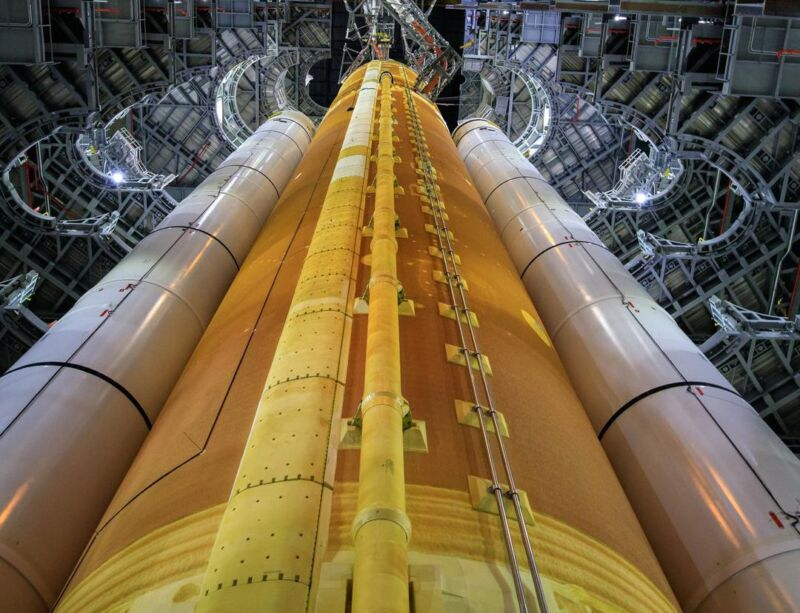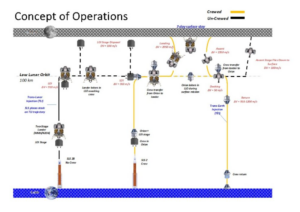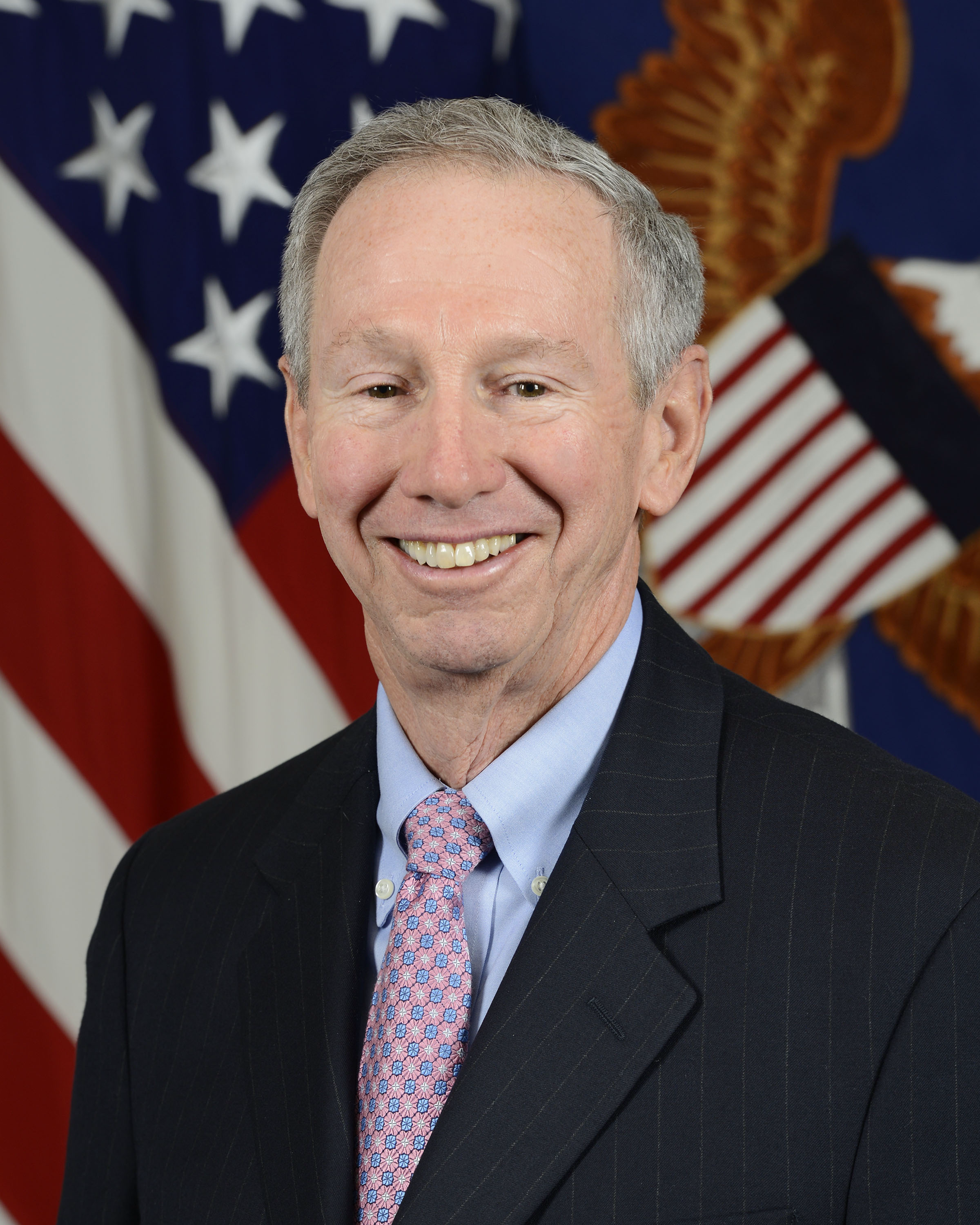Returning Humans to the Moon
How the United States Can Actually Get There Instead of Watching China Do It
Mike Griffin
Co-President
LogiQ, Inc.
Sponsored by PSW Science Members Ajay Kothari and Ravi Deepak
About the Lecture

On January 17th of this year (2024) the speaker testified before the House Science Committee, advising that the Artemis Program, NASA’s effort to return humans to the Moon, “is excessively complex, unrealistically priced, compromises crew safety, poses very high mission risk of completion and is highly unlikely to be completed in a timely manner even if successful . . . . We need to restart it.”
This lecture will discuss an alternative approach using two launches of the SLS Block 2 heavy-lift launch vehicle, one carrying a lunar lander and transfer stage and the other a crewed Orion spacecraft and transfer stage. The two would dock in low lunar orbit to transfer astronauts to the lander, spending a week on the surface before returning to Orion for the trip home. Relevant analysis supporting this architecture will be presented.
The speaker will also discuss the importance of human space exploration to national security as it relates to our ongoing competition with the Chinese Communist Party for primacy in the projection of global power and influence.
Selected Reading & Media References
(1) https://www.nytimes.com/2021/04/16/science/spacex-moon-nasa.html
(2) https://www.reuters.com/technology/space/nasa-name-second-company-build-astronaut-lunar-lander-2023-05-19/
(3) https://www.newsweek.com/russia-approves-plan-establish-lunar-base-china-1848731

About the Speaker

Michael D. Griffin is the Co-Founder and Co-President of LogiQ, Inc., a company providing high-end management, scientific, and technical consulting services. He was previously the Under Secretary of Defense for Research and Engineering, and in that role shared responsibility with the Deputy Under Secretary for research, development, and prototyping activities within the Department of Defense. In prior roles he was the Chairman and CEO of Schafer Corporation, the King-MacDonald Professor at the University of Alabama in Huntsville, the Administrator of NASA, Space Department Head at the John Hopkins University Applied Physics Laboratory, President of In-Q-Tel, CEO of Magellan Systems, and EVP and General Manager of Orbital ATK’s Space Systems Group.
Mike is the lead author on two dozen technical papers and the textbook Space Vehicle Design. He is a Registered Professional Engineer in Maryland and California. And he is a Certified Flight Instructor with instrument and multiengine ratings.
Among other honors and awards, Mike is a member of the National Academy of Engineering and the International Academy of Astronautics, an Honorary Fellow of the American Institute of Aeronautics and Astronautics, a Fellow of the American Astronautical Society, and a Fellow of the Institute of Electrical and Electronic Engineers. He has received the NASA Exceptional Achievement Medal, the AIAA Space Systems Medal and the Goddard Astronautics Award, the National Space Club’s Goddard Trophy, the Rotary National Award for Space Achievement, the Missile Defense Agency’s Ronald Reagan Award, and he has twice been awarded the Department of Defense Distinguished Public Service Medal. He also has been recognized with honorary doctoral degrees from Florida Southern College and the University of Notre Dame.
Mike has earned seven degrees: a BA in Physics at the Johns Hopkins University, an MSE in Aerospace Science at the Catholic University of America, a PhD in Aerospace Engineering at the University of Maryland, an MS in Electrical Engineering at the University of Southern California, an MS in Applied Physics at the Johns Hopkins University, an MBA at Loyola University Maryland and an MS in Civil Engineering at the George Washington University.
Social Media
LinkedIn: https://www.linkedin.com/in/michael-griffin-8209101b2/
Minutes
On June 14, 2024, in the Powell Auditorium of the Cosmos Club in Washington, D.C., President Larry Millstein called the 2,498th meeting of the Society to order at 8:04 p.m. ET. He began by welcoming attendees, thanking sponsors for their support and announcing new members. Scott Mathews then read the minutes of the previous meeting which included the Presidents Forum. The minutes were approved as read.
President Millstein then introduced the speaker for the evening, Mike Griffin, of LogiQ Inc. His lecture was titled “Returning Humans to the Moon: How the United States Can Actually Get There Instead of Watching China Do It”.
The speaker began by presenting a brief history of human exploration of the moon: beginning with President Kennedy’s “Man, Moon, Decade” speech in May of 1961, Apollo missions 11 through 17 between 1969 and 1972, the cancellation of the Apollo program by the Nixon administration, the Space Shuttle Program, initiated in 1972, and the International Space Station Program, initiated in 1984. He described the “Return to the Moon” Program, initiated by George H.W. Bush in 1989, which was subsequently cancelled by the Clinton administration. In 2004, under the George W. Bush administration, plans to complete the International Space Station, retire the Space Shuttle, and develop a new crew transportation system for a return to the moon were announced. The programs for the new crew transportation system and return to the moon were cancelled by the Obama administration.
Griffin expressed the opinion that the last 50 years of space exploration in the United States had no clear goal or theme. He indicated that he believed the Apollo program was fiscally sustainable; it was simply not sustained. He stressed the need for strategic goals to drive the US space program, saying that “the question about the vision for space exploration boils down to whether we want to incorporate the solar system in our economic sphere or not.” He emphasized the importance of being first, particularly with respect to beating the Chinese. He speculated that China will likely achieve a human lunar landing by 2030.
He then discussed the space programs currently being pursued by the US: Artemis II- 2025 circumlunar swingby, Artemis III- 2026 uncrewed landing in the south pole region, Artemis IV- 2028 Deployment of Lunar Gateway, Artemis V- 2030 Four crew to the lunar surface.
Griffin then discussed the details of these proposed lunar missions in rather technical terms. He discussed and described: orbit plane, arrival and departure trajectories, near-equatorial vs. polar landing sites, return timing with respect to orbital position, and urgent abort to the mothership. He showed diagrams of the “Concept of Operations” for both the SpaceX Artemis III and Blue Origin Artemis V missions. Griffin raised several criticisms about both mission scenarios, particularly with respect to the number of required tanker flights, overall mission complexity, risk to crew, and lack of options for mission abort or rescue. Griffin said “The Artemis architecture imposes penalties without benefits.”
The speaker then discussed an alternative two-launch scenario which he claims would be lower risk. This approach would use the SLS Block 2 Cargo variant to launch an uncrewed lander, and the SLS crew variant with the Orion spacecraft, launched separately to rendezvous with the lander in low lunar orbit. Griffin presented the details of the proposed two launch architecture: lander launched first to low lunar orbit, crew in Orion launched later, crew transfer from Orion to lander in low lunar orbit, descent of lander for 7-day surface mission, rendezvous with Orion in low lunar orbit, return to Earth via Orion.
The speaker concluded his talk by saying that there exists at least one, conservatively designed, low-risk, two launch human lunar mission architecture which satisfies all NASA’s requirements.
The lecture was followed by a Question and Answer session:
The president asked the speaker what the strategy should be to achieve the goals associated with human space exploration. Griffin responded by saying “The strategic goal is to expand the range of human action, as we have done for a million years, and the next place to expand it is the solar system, and the United States should take the lead.”
A member asked about just how sustainable Apollo was, in its time, and whether or not we could revive some of the hardware from Apollo. Griffin responded “Of course you could, but we can do better.”
A member asked about why the SpaceX plan required so many fuel runs. Griffin responded that the SpaceX plan has so much “delta-V” penalty on the lander that it requires very large amounts of fuel.
A member asked about the need for humans in these space missions, claiming that robots and computers are capable of doing more than human beings. Griffin responded that “expanding the range of human action is as noble a goal as scientific discovery.” Griffin acknowledged the successes achieved by robotic space systems like the Hubble and the Mars rovers, but he said that “Nobody cares. What they care about is the human adventure.”
A viewer on the livestream asked if the Boeing SLS should be scraped because it is so costly. Griffin said “No.”
A viewer on the livestream asked what cultural problems NASA needs to solve in order to allow more common-sense engineering. Griffin responded that the cultural problems are not limited to NASA, but are seen across the US government. He cited several examples of government projects that came in over budget, failed to meet deadlines, or were otherwise ineffective. He said “The cultural problem that needs to be fixed starts at the very top of the nation.”
After the question and answer period, President Millstein thanked the speaker and presented him with a PSW rosette, a signed copy of the announcement of his talk, and a signed copy of Volume 1 of the PSW Bulletin. He then announced speakers of up-coming lectures, made a number of housekeeping announcements, and invited guests to join the Society. He adjourned the 2498th meeting of the society at 9:43 pm ET.
Temperature in Washington, DC: 28.3° Celsius
Weather: Mostly cloudy
Audience in the Powell auditorium: 111
Viewers on live stream: 43 …for a total of 154 live viewers
Views of the video in the first two weeks: 690
Respectfully submitted, Scott Mathews: Recording Secretary